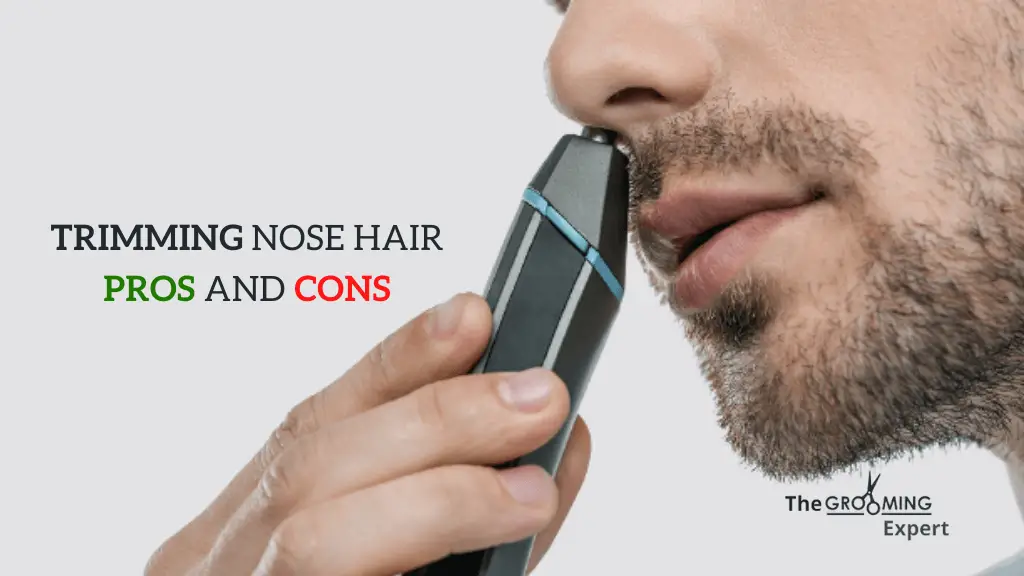What are Trimming Nose Hair’s Pros and Cons? Nose hair protects your respiratory system from airborne debris and protects the mucous layer, doubling as a barrier against contaminants. Unfortunately, nose hairs are also easy to remove, leaving the mucous layer vulnerable to damage and causing respiratory problems.
It is generally recommended to trim it every two weeks, but everyone’s situation is different. While long nose hair helps with allergies, it can also be an irritant or cause discomfort. Trimming it too often can also cause problems with sensitivity. You can trim the hairs just enough to remove them or too often if you feel that they’re too long.
Leaving some of them is a good idea, and you should only trim the unsightly ones. This article will explain why trimming your nose hair is a good idea. As it turns out, it can even be beneficial for your immune system.
SHOULD I TRIM MY NOSE HAIR?
Should I trim my nose hair? It’s a question that has crossed my mind more than once during my grooming routine. Nose hair serves a vital function in our bodies, acting as a natural filter to keep dust, allergens, and bacteria out of our nasal passages. However, there comes a point where it becomes a matter of aesthetics and comfort. For me, it was when I noticed that my nose hair was becoming more noticeable and even protruding from my nostrils. It was not a particularly pleasant sight, and it made me self-conscious.
That’s when I decided it was time to trim it. I invested in a specialized nose hair trimmer designed for this purpose, which made the process quick and painless. Trimming my nose hair has helped me strike a balance between looking well-groomed and maintaining the protective function of nose hair. So, if you find yourself in a similar situation, don’t hesitate to give it a try with one of the reliable trimmers in the market – just be sure to use the right tools to do it safely and effectively.
Trimming Nose Hair Pros and Cons – Whole Guide
With different benefits and cons, nose trimming is one of those processes that people get confused about. We are providing you with conclusive details about the nose trimming.
Trimming Benefits
Even though your nose hair is a protective function, you may be wondering if trimming it is beneficial. Hormones and aging cause the growth of nasal hair. While you might not be at risk of disease by trimming your hair, experts say it is a myth. By using a particular trimmer designed for nose hair, you can make sure that you leave only the most visible strands.
Although hair in the nose may cause discomfort, it still serves a valid biological purpose. It protects the respiratory system from harmful airborne particles. However, trimming can compromise that function and lead to nicks and infections.
Electric nose hair trimmers are an excellent option for those who don’t want to risk accidents while trimming. Furthermore, these devices are affordable, easy to use, and designed to reach difficult spots without harming the nose.
Among the most common nose hair trimmers, a nose hair trimmer allows you to shorten one or two protruding hairs and leave the rest intact. In addition to being safe, nose hair trimmers can promote the growth of new hair on the nose.
Laser hair removal is safer than removing your nose hair, but it is expensive and may not be covered by health insurance. Laser hair removal targets only the visible protruding hairs and destroys the follicle at its root.
It’s not clear why long-nose hair helps with allergies, but the main benefit is that it can trap a lot of stuff. Sneezing, which is designed to remove things you don’t want to breathe in, is often more difficult when there’s a buildup of nasal hair.
The resulting nasal “damn” is disgusting. Longnose hair can help reduce the risk of sinus problems by protecting against a more comprehensive range of allergens.
Some people believe that long nose hair is good for them, while others believe it can trigger allergic reactions. However, this isn’t entirely true. Although long nose hair serves a protective purpose, it’s also unsightly.
Does trimming nose hair help breathing?
Nose hair is a natural defense mechanism against dust and other pollutants that enter the body. While many people trim it to make them look younger, this is not a healthy practice. It is uncomfortable, but it also can aggravate respiratory ailments, especially if it grows too long.
Additionally, longer hair cannot remove dust, clog the nose, and block breathing. So, the question remains: does trimming nose hair help breathing? While nasal hair serves a biological function, it also looks sloppy and can cause allergic reactions.
.png)
It is because it forms a barrier between the respiratory system and the outside environment. While it may be unsightly to shave your nose, it can increase your chances of developing asthma.
Fortunately, there are several ways to get rid of excess hair while maintaining a healthy appearance. You can trim your nose hair without compromising its vital role by following a few simple rules.
While it’s tempting to shave away your nose hair as soon as you notice it, you’re doing yourself a disservice. Leaving your nose hairs untrimmed can lead to an infection or even ingrown hair.
Fortunately, these infections are sporadic. The best way to treat them is to use a mild solution that doesn’t involve shaving. You can also use a rag wet with warm water and gently slough off the ingrown hair.
Nose Hair Immune System
The immune system of your nose depends on the nose hairs that protect it. The hairs trap debris and other pollutants in the nasal cavity, helping to keep the body free of allergens and other harmful substances.
Researchers divided subjects into two groups based on their nose hair density. They found that people with more nose hairs had lower seasonal allergies and asthma rates. In addition, a thick layer of mucus is good for the nose, helping to trap dust and other particles.
How often should you trim your nose hairs?
In addition to being aesthetically pleasing, nose hairs also serve a functional purpose. They filter air and trap debris, irritating the skin inside the nostrils. While this function is vital to the body, people often trim their nose hairs for aesthetic and sanitary reasons. However, there are certain precautions you should take when trimming nose hairs.
To begin, use an excellent antiseptic ointment or gel. These are intended to kill bacteria and moisten the skin inside the nostrils. These products also soften and remove any unwanted hair.
It is a good idea to moisturize the inside of your nostrils before trimming. Depending on your personal preference, trimming your nose hairs may require as little as a once-a-week visit to a professional.
Avoid waxing and plucking because they can lead to ingrown hairs and infections. Additionally, if you use pointed scissors, you can puncture mucous membranes inside the nose. It can cause a painful infection.
Furthermore, a study found that nasal hairs have a protective function for the body, so removing too much could make you more sensitive to allergens. So, it’s essential to follow a professional’s instructions to prevent infections.
Will trimming nose hairs help allergies?
No evidence that trimming nose hairs helps allergies. It may increase the risk of allergies, sinus infections, and a bloody nose. But it does not mean you should stop shaving your nose hairs altogether. The more you trim them, the less likely they’ll become noticeable, so you may as well trim them as often as possible.
You better avoid any over-plucking. Ingrown hairs can cause a rash or ingrown hairs, aggravating allergic symptoms. Using a regular tool to trim your nose hairs is an excellent way to keep your symptoms down.
Nose hairs play a vital role in your body. They act as a filter for harmful germs, spores, and fungi. If you pluck out these hairs, you’re exposing yourself to more allergens and increasing your risk of developing allergies and asthma.
However, a study conducted at the Mayo Clinic examined the effects of nose hair removal on the risk of asthma later in life in patients with seasonal allergies. The more minor nose hair patients were more likely to develop asthma.
Does trimming hair make it grow faster?
The truth is, there is no natural way to make nose hair grow faster. It doesn’t grow thicker or faster when you pluck it, unlike facial hair. The opposite is true. Your nose hair is a vital part of your invulnerable framework and a channel for protecting your lungs and blood from allergens.
As a result, plucking can cause severe health problems, such as brain abscesses and even meningitis. Further, plucking your nose hair may harm the follicles that produce hair, which can halt growth.
To begin, trim the hair on your nose using blunt-end scissors. These scissors have smooth, rounded edges, making them safe for use inside the nose. Before shaving, make sure that the cutting tool is clean and has no damaged parts, and hold your nose upright with the tool inserted inside your nostril.
Try to visualize the nose hair, if possible, by pushing your face up or grimacing. Once you’ve cut the hair, wait a week. You’ll notice that it regenerates after that.
Read Also: How to Shave with a Safety Razor
Cons of Trimming Nose Hair
You may wonder why people insist on trimming nose hair so frequently. It is unnecessary to do so daily, but it is a good habit to establish. Trimming your nose hair can improve your appearance and overall health. Also, keep in mind that you should not pull your hair with force.
The resulting cut is painful, but it can also cause more problems. First, it can cause damage to the sensitive skin inside your nose. Trimming with scissors can cause minor lesions or ingrown hairs.
Secondly, it can be painful and can even lead to infection. Investing in a quality nose hair trimmer is an intelligent idea. Secondly, you don’t have to worry about pulling and catching the hair.
It can be Irritant
When you trim your nose hair, you may experience ingrown hair. These hairs are painful and ingrown when dry. To prevent ingrown hairs, you should moisten the skin with a warm cloth or hot water after shaving. Afterward, wipe the area with a disinfectant to prevent infection. Remember to rinse the area thoroughly before starting the next hair-clipping session.
You can also apply antiseptic ointments directly onto your nostril. Antiseptic ointments are primarily used to kill bacteria, but most moisturize and soften trimmed hairs. Using antiseptic ointments is not only an option to relieve irritation but can also make nose hair removal more comfortable. But be sure not to use tweezers to remove ingrown hairs.
While your nose hair is there for a protective function, cutting it is not pleasant. It can cause allergies because it filters allergens and is unsightly. Air pollution is a significant health issue that costs the US economy 4.2 million lives every year. Air pollution also hurts health in many Asian countries, making it a harrowing process for people who suffer from respiratory problems.
There are many advantages to using a pair of professional scissors for trimming nose hair. Unlike ordinary scissors, these devices are made especially for this purpose. They have a specially designed safety upper to reduce the risk of ingrown hair.
And best of all, they were cheap! And you can buy them online or at a local department store. This way, you can save money and time and avoid the risk of accidental accidents.
Read Also: How to Epilate Correctly
SHOULD I PLUCK MY NOSE HAIR?
It is advisable to avoid plucking nose hair, as this practice can potentially result in ingrown hairs or infections. According to Dr. Michael Falcone, an ENT doctor at CEENTA, aggressively grooming nasal hair can lead to the development of painful bumps within the nasal passages. These bumps are medically referred to as furuncles or boils.
It Can Cause Discomfort
When you want to trim your nose hair, you can avoid these problems by following these tips. Trimming the hair with tweezers or plucking hard can cause ingrown hairs. Ingrown hairs are painful and can lead to infection. You can use a wet washcloth to remove the ingrown hair. Afterward, gently press your nose shut to release any discomfort.
.png)
Using a pair of grooming scissors with rounded tips will prevent you from infecting yourself when trimming your nose hair. You can also practice safe trimming techniques by using good lighting and taking your time.
Trimming nose hair with tweezers can cause uncomfortable ingrown hairs and even nasty skin infections. The hairs might grow back, but you might have bumps that look like pimples.
You can also avoid trimming your nose hair using small cuticle scissors. You should use these scissors only if you have sensitive skin. However, you should avoid trimming your nose hair entirely, as this can lead to discomfort and infection.
Moreover, plucking and waxing your eyebrows can cause ingrown hairs, so they should be left alone. When you want to shave your eyebrows, make sure you buy one specially designed.
If you choose to tweeze your nose hair, use a pair of scissors with a small tip and sharp blades. Keep the scissors clean after use, and never share your tweezers with others. The tweezers should have a sharp point that can sever hairs easily with one quick snip. Afterward, rub your skin with water.
if your nose trimmer is not working you can read our detailed article on Troubleshooting guide.
How to remove hair from the nose tip naturally?
Hair can grow on the tip of your nose for various reasons. Some of these hairs are Vellus, which absorb sweat and help regulate body temperature. However, there are also methods for removing hair from nose tips that are effective and completely harmless.
It is essential to have a well-lit mirror and a place to dispose of any hairs. Ensure you have good lighting, as the hairs on the tip of the nose are usually lighter than the hair on the rest of the face. Also, get close to the mirror, if possible, and use a magnifying mirror to see the hairs better. Alternatively, you can use a hand-held mirror to help you see the hair more clearly.
One of the most common at-home methods of hair removal is trimming. You can use rounded-tip scissors to trim hairs on the nose. Make sure that you do not cut too close to the nostril with a regular pair of scissors.
Another safe, effective at-home solution is an electric nose hair trimmer. These devices are small enough to be moved around the nose tip to remove hair. Regardless of the method you choose, you should always ensure that you are working with a sterile needle, as it may have some side effects.
Final Words
In terms of Trimming nose hair pros and cons, we have explained and answered every possible question one can ask. Every person’s situation is different, but trimming it every two weeks is recommended. Even though long nose hair can help with allergies, it can also be irritating or uncomfortable to wear. Frequent trimming can also lead to skin problems. If the hairs are too long, you can trim them as much as necessary.

Meet Irwin Jolly, the grooming expert passionate about men’s grooming products. Irwin has been in the industry for years, and he’s tried and tested hundreds of grooming products to help men achieve their desired looks. Regarding grooming, skincare, and hair styling, Irwin knows what works and what doesn’t. His reviews are honest and thorough, and he doesn’t promote anything he hasn’t tried and tested. He believes grooming is essential to self-care, and he’s dedicated to helping men look and feel their best.

